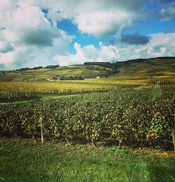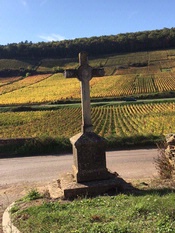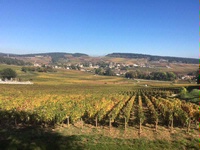Burgundy can evoke any number of thoughts and feelings among wine enthusiast, experts, and professionals. Certainly ideas of legendary Pinot Noir and Chardonnay Grand Cru and Premier Cru spring to mind, as do memories of studying maps, regional history, and wine guides to try to comprehend its intricate and confusing framework. Emotions vacillate between wonder, excitement, and intimidation at the thought of zipping around the Grande Route du Vins for a few days. I know this because that’s how I felt when invited by the Burgundy Wine Board to spend an  exploratory week in the region. Having been a self-guided student of wine for the past decade or so, I was eager to see the iconic region with my own eyes.
exploratory week in the region. Having been a self-guided student of wine for the past decade or so, I was eager to see the iconic region with my own eyes.
I arrived in mid-October, just as the 2017 harvest had drawn to a close. The air was cool, and customarily humid and the vineyards, spent from a full growing season, were already taking on hues of yellow, orange, and red. We began our quick immersion into the region at the Southern end in the Mâconnais and worked our way north through the Côtes de Nuits over the week. Although we could have used a full year to really dig deep into the riches of Burgundy’s framework–and I have the notes that may take exactly that long to deliberately sift through–I was struck by a few takeaways about the region, some new discoveries, and others happy reminders.
1) For Value, the Mâconnais is Where It’s At: The most southerly region, and the largest of Bourgogne, is the Mâconnais, right next to Beaujolais. Its southern location means it’s the warmest region of Burgundy producing wines that are a bit riper, fleshier and fuller compared to its counterparts further north.
Many may be familiar with the Chardonnay of Pouily Fuissé, but by and large, the Mâconnais is made up of many less familiar villages that also produce amazingly good value Chardonnays (St. Véran, Pouilly-Venzelles, and Pouilly-Loché, to name a few).
Here, Pinot Noir and Gamay are fairly common, but it’s white wine from Chardonnay and Aligoté that lead the region. On account of the relatively warm climatic conditions, Chardonnays are usually un-oaked, and tend to feature notes of ripe stone fruit, melon and bright citrus in wines that are balanced with elegant structure. And the best part about them is that they tend to hover between $15-$20 for a good Villages-level wine.
A great entry-point for those curious about Burgundy, but not quite ready to make a big investment, these wines are generally lively, vivacious and wonderfully approachable. And among its 43 villages, the varying terroirs produce wines brimming with different characteristics to discover, as a morning tasting through 18 Chardonnay selections from Domaine Thibert clearly revealed to me.
2) Aligoté Deserves a Better Rap: For years, Aligoté has played second fiddle to Chardonnay throughout Burgundy. Aligoté produces, light, fresh, and nimble wines often with floral, herbal and citrus notes that have certainly afforded the reputation for the grape as an aperitif variety. But many of the wines I tasted had a little more depth and elegance that I had anticipated.
Although much of it is found in the more Southern regions of Mâconnais and Côte Chalonnais, its plantings along more inferior vineyards sites on hilltops and flatlands (rather than the sloped hillsides saved for Chardonnay) have led many to believe it is a grape best left in general obscurity. But if that’s the case, then why is it still so widely planted? And more important, why are so many producers, including Domaine Nicolas Maillet, Domaine Marc Jambon et Fils, and Marc and Jean Baptiste Jessiaume of Maison Chanzy so passionate about producing it? (And not just in Bouzeron, the only AOC devoted to its production.)
I was pleasantly surprised to find that with each new producer we visited in the Mâconnais and Côte Chalonnais, almost every one was excited to pour their Aligoté–even a sparklingCrémant from Vitteaut Alberti made with a hearty percentage of the grape. I was particularly curious to see a few different styles of it from Maison Chanzy who had three different and distinctive offerings.
Indeed, with its popularity throughout the more southern regions, it’s a wonder it hasn’t found more of a presence in the U.S., but then again, considering its reputation as an every day wine for Burgundians, perhaps they’re content to keep the majority of it for themselves.
3) Mercurey Rising: Situated in the heart of the Côte Chalonnaise, Mercurey is known for its deep-colored Pinot Noir boasting notes of red fruit and tertiary notes of underbrush and spicy tobacco. Red wine  accounts of the lion’s share of the region, but Mercurey also produces elegantly structured Chardonnay with notes of flint, white flower, and hazelnut when aged.
accounts of the lion’s share of the region, but Mercurey also produces elegantly structured Chardonnay with notes of flint, white flower, and hazelnut when aged.
While the sampling of wines I tasted were certainly impressive, I was most impressed with the strength of local producers in terms of banding together to promote the region. We made a quick stop in the village of Mercurey at Caveau Divin Mercurey, where visitors can sample from more than 40 wines, each from a different producer within the appellation. Producers provide their wines to the veritable wine bar in an effort to allow people to taste the range of Mercurey wines. Guests simply purchase a prepaid card and opt for different pours of the wines displayed in a commercial by-the-glass dispenser in specified measurements.
Often times when visiting a wine region, you’re left with an incomplete picture based on the handful of producers you may be able to visit. In this case, you can fill in that picture quite a bit more to get a better understanding of the quality and depth of character the wines of Mercurey have to offer. In this case, it was clear the producers of the region understand that a rising tide raises all boats. Working together to present their wines in one location allows visitors a much clearer representation of the appellation as a whole than can usually be enjoyed.
4) Don’t Be Intimidated By The Hype! This Region Should Be Enjoyed: While it is true it’s difficult to get appointments with many of the Grand Cru and Premier Cru producers in Bourgogne, and that the region is, in its own charming way, a quiet, rural region, somehow caught in a simpler time, Burgundy is fairly accessible for the average wine traveler.
People forget that Grand Cru only accounts for 1 percent of the overall wine production in Burgundy, which means that there’s a whole lot of this region that’s easy to explore. The historic towns of Mâcon and Beaune are comfortably walk-able with excellent restaurants and boutique shops to stroll and the smaller hamlets scattered throughout the region are even more enjoyable to discover. If you’re looking for wine-centric visit, Olivier Leflaive in Puligny-Montrachet emphasizes the importance of hospitality near its production facility with a full-scale restaurant that offers a tasting menu paired with seasonal cuisine as well as a Four-Star  boutique hotel with concierge services to schedule tasting appointments and rooms that each afford views of vineyards beyond the village.
boutique hotel with concierge services to schedule tasting appointments and rooms that each afford views of vineyards beyond the village.
For a more independent experience, visitors to Mercurey can take a tasting at the Château de Chamirey can taste from a selection of wines from the Devillard family estates: Château de Chamirey (Mercurey), Domaine des Perdrix (Côte de Nuits), Domaine de la Ferté (Givry), and Domaine de la Garenne (Mâcon-Azé), all of which are owned and operated by the Devillard family, whose history in the region dates back for multiple generations. Guests can linger over a tasting lunch overlooking the family vineyards while enjoying wines artfully paired with each course. And for those wishing to spend a few days in the area, the Chateau de Chamirey also offers a charming guest cottage, the Clos du Roi, originally built in the 19th century that sleeps six and is happily situated amid the family’s most prized vineyards.
And if you’re looking for someone to help arrange appointments and help guide you around for a few days, there are a number of services you can hire to accommodate. I was personally thankful for our friendly and professional guide, Stevie Bobes, a.k.a. the Wine Ambassadeur. An American ex-pat who has spent the past 20 years in the region, he not only had a great understanding of the wines throughout the region, but also has a great rapport with many of the region’s producers. (He’s also helpful with French translation.)
5) 2017, It Was A Very Good Year: Perhaps the most important take away from my recent visit was the excitement over the recent 2017 vintage. Everything was harvested by early October, and producers all up and down the region from the southern points of the Macon all the way through the northern parts of the Côtes de Nuits are raving about this year’s vintage; not only for its quantity but also for its quality. This is great news for a region that has suffered greatly in previous years from late freezes and devastating hailstorms.
In truth, seven days in Burgundy is barely enough to scratch the surface of what this fabled region has to offer, but it left me with a treasure trove of stories to explore, and quite a bit more to savor.
